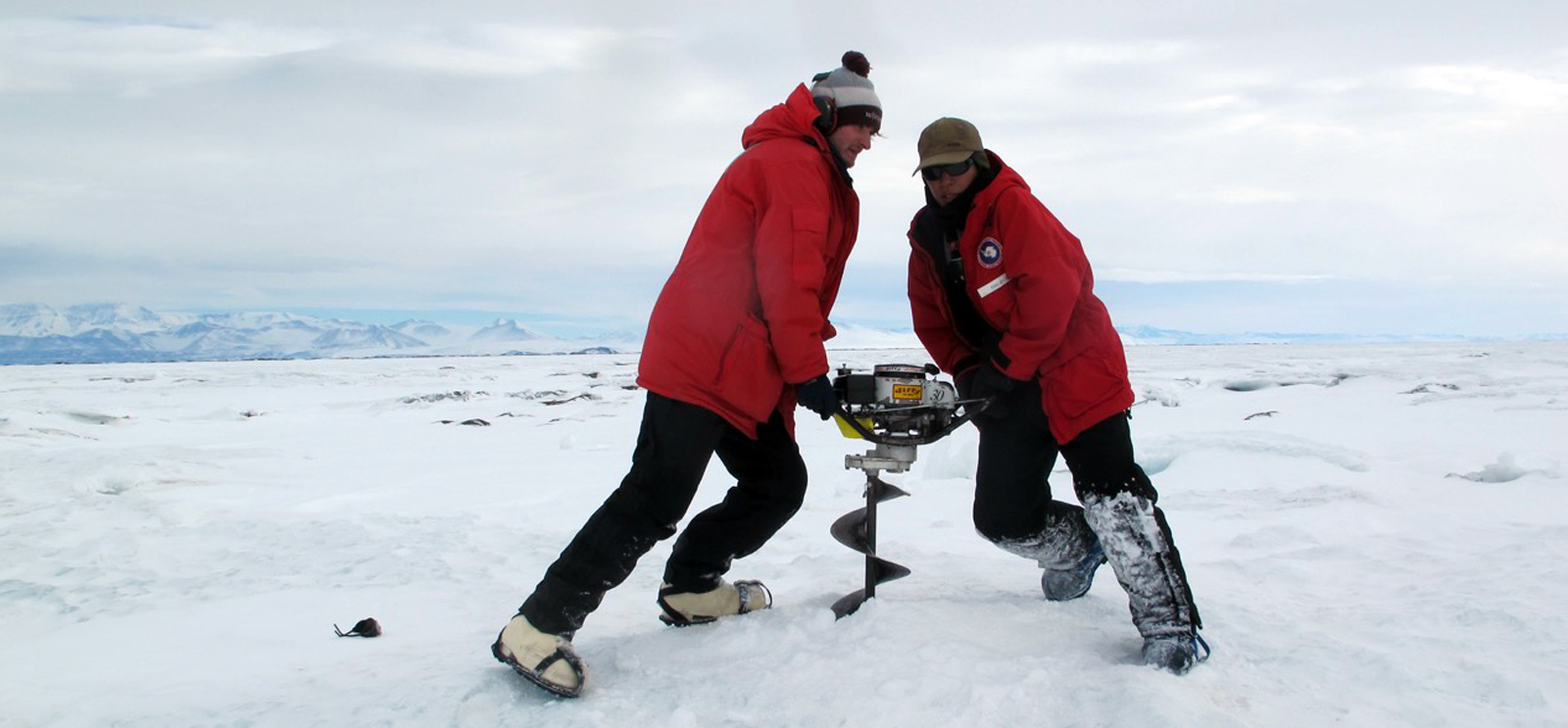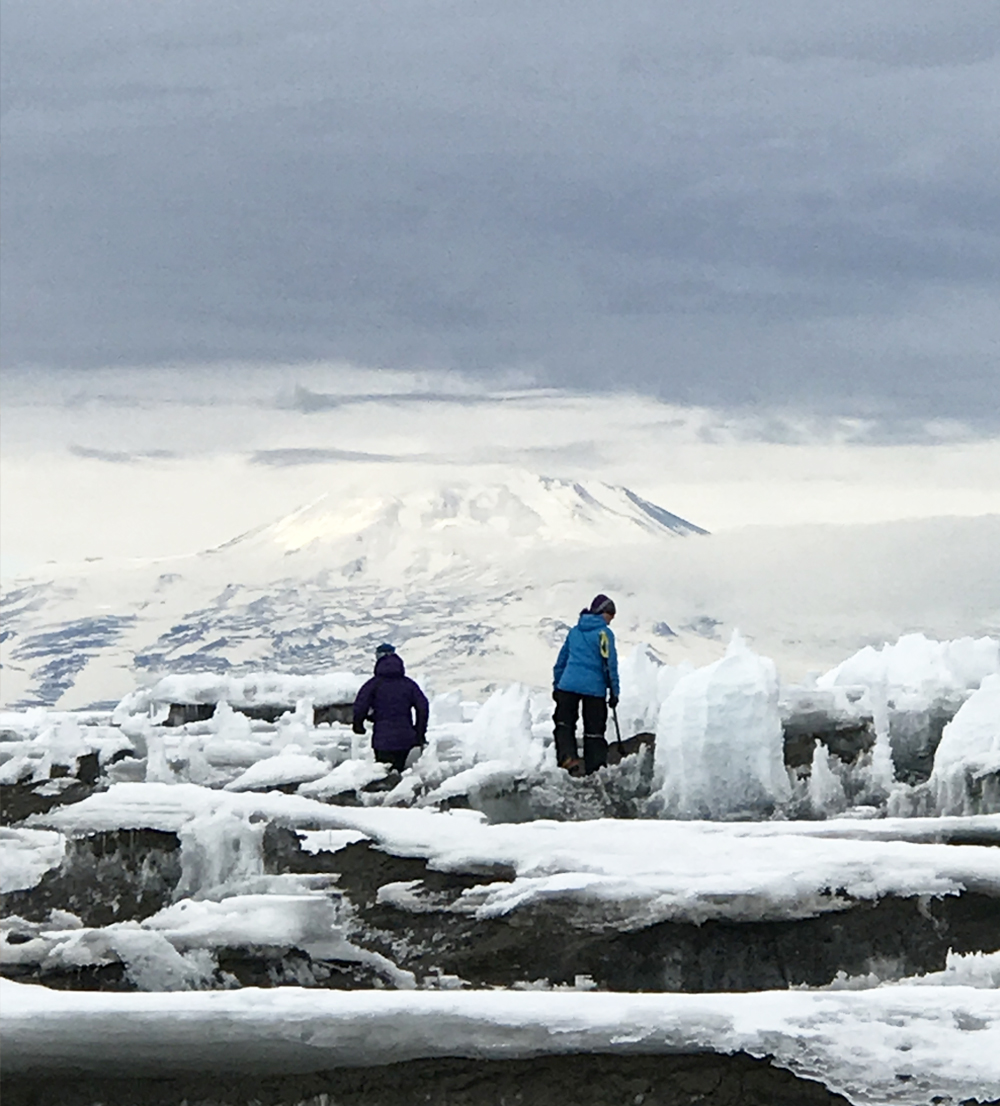
Physical Sciences Division graduate student Grant MacDonald and a National Science Foundation collaborator install a seismometer in an ice shelf to detect tremors associated with fractures and meltwater movement. (Photo courtesy Douglas MacAyeal)
What listening to icebergs tells us about the future of the Antarctic.
Forty-one years ago Douglas MacAyeal was a Princeton graduate student on his first field expedition to Antarctica. Standing on a vast, barren sheet of ice at the bottom of the world, “you could see almost beyond the horizon,” recalls MacAyeal, UChicago professor of geophysical sciences. He was captivated. Surrounded by an endless snowscape underneath a clear blue sky, “you get thinking that you are the only person in the world that has ever walked within that view.”
MacAyeal was also standing on the precipice of a relatively new scientific field. The term “global warming” had been coined a year before his first voyage to Antarctica, and he joined the University’s geophysical sciences department in 1983, just as research was beginning to suggest the threat that greenhouse warming might pose to ice in Antarctica and elsewhere.
“The visceral act of being in Antarctica coupled with the fact that it was such a pioneering new area of study swept me away,” he says. “I couldn’t not be a glaciologist.”
MacAyeal studies the behavior of large ice sheets, also known as continental glaciers—how they move, melt, and break apart—and combines fieldwork with computer modeling and theory to understand how this behavior is related to climate change. Over the course of his career, which has included 13 expeditions to Antarctica, he’s seen the continent’s ice and very shape change as the global climate does.
He’s heard those changes too.

In 2001 MacAyeal was studying an iceberg with a surface area larger than Connecticut that had broken off from Antarctica’s ice shelves, the permanent floating masses of ice that surround the continent. Icebergs are the main way ice leaves Antarctica; as snow falls “it builds up to the point where it actually has to flow off.” The snow turns into sheets of ice that slide toward the ocean, slowed by the ice shelves. (If Antarctica were an upside-down pie tin, he says, the ice shelves would be the lip.) Eventually, pieces of ice break off, or calve, into the ocean as icebergs. Glaciologists closely monitor this process, comparing the amount of snow falling on the continent to the amount of ice drifting away—“like bank accountants,” says MacAyeal.
He also wanted to observe an iceberg as it floated into warmer waters, to help better model what might happen to the rest of Antarctica if ocean temperatures continue to rise. Inspired by a colleague’s work monitoring underwater tremors, MacAyeal put seismometers on the icebergs and started recording. From the varied sounds—such as the hours-long, solemn groan of two large icebergs scraping against each other and the sudden bang of an iceberg calving from an ice sheet—MacAyeal’s team found they could track the icebergs by the noises they make. So they kept listening.
The recordings provide more detailed information about the icebergs’ movements and indicate when they are “doing things that we wouldn’t otherwise be able to see either with a satellite or with human observations,” MacAyeal says. For instance, they tip off researchers when an iceberg is being pushed by a current or beginning to break up.
Recently with his graduate students, MacAyeal recorded and studied the “snap, crackle, and pop” of a daily melting and freezing cycle of the top layer of an Antarctic ice shelf. The ice shelves have become a primary focus for MacAyeal as increasingly warm water has affected the ice’s ability to refreeze, and larger, heavier pools of meltwater strain the remaining ice, further speeding up the shelves’ disintegration. The smaller these shelves, the less “buttressing,” in glaciologist speak, they provide, meaning the continent’s ice sheets will more quickly become icebergs. Then it’s like “pouring more ice cubes into the cocktail bowl,” says MacAyeal—sea levels will rise.
Modern glaciology is focused on sea level change, as MacAyeal told Anthony Bourdain when the CNN host trekked to McMurdo Station, the largest research base in Antarctica, this spring for an episode of his show Parts Unknown. Over a drink at one of the research station’s three bars, MacAyeal explained that “we’re still trying to figure out what Antarctica is doing in terms of sea levels”—how changes in the ice shelves or the iceberg calving process will affect the world beyond McMurdo. The goal is to create “some kind of a solid, reliable statement about what cities like San Francisco and New York and Shanghai have to plan for.”
The United Nations currently estimates that the world’s sea levels are on track to rise more than 40 centimeters by 2100, a prediction based on MacAyeal’s work and that of many other glaciologists. In the 1980s and 1990s, MacAyeal was one of only a few scientists creating models of Antarctic ice sheets; now, he estimates, the number of glaciologists “has grown by a factor of 10 to 100.” None knows for sure how a changing Antarctica will change the world, but they’re doing everything they can to find out.
